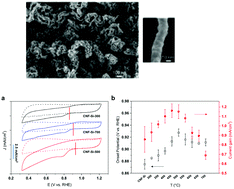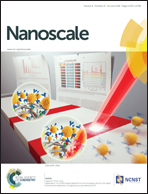Reproducibly creating hierarchical 3D carbon to study the effect of Si surface functionalization on the oxygen reduction reaction†
Abstract
We report a new method to reproducibly fabricate functional 3D carbon structures directly on a current collector, e.g. stainless steel. The 3D carbon platform is formed by direct growth of upright arrays of carbon nanofiber bundles on a roughened surface of stainless steel via the seed-assisted approach. Each bundle consists of about 30 individual carbon nanofibers with a diameter of 18 nm on average. We have found that this new platform offers adequate structural integrity. As a result, no reduction of the surface area during downstream chemical functionalization was observed. With a fixed and reproducible 3D structure, the effect of the chemistry of the grafted species on the oxygen reduction reaction has been systematically investigated. This investigation reveals for the first time that non-conductive Si with an appropriate electronic structure distorts the carbon electronic structure and consequently enhances ORR electrocatalysis. The strong interface provides excellent electron connectivity according to electrochemical analysis. This highly reproducible and stable 3D platform can serve as a stepping-stone for the investigation of the effect of carbon surface functionalization on electrochemical reactions in general.


 Please wait while we load your content...
Please wait while we load your content...